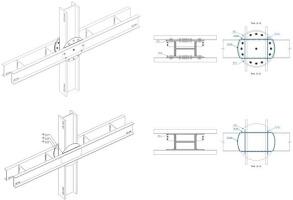当前位置:
X-MOL 学术
›
J. Constr. Steel Res.
›
论文详情
Our official English website, www.x-mol.net, welcomes your
feedback! (Note: you will need to create a separate account there.)
A new friction-slip connection for moment frames with continuous beams
Journal of Constructional Steel Research ( IF 4.0 ) Pub Date : 2020-12-01 , DOI: 10.1016/j.jcsr.2020.106337 Fereshteh Seifan , Seyed Rasoul Mirghaderi , Mehdi Ghassemieh
Journal of Constructional Steel Research ( IF 4.0 ) Pub Date : 2020-12-01 , DOI: 10.1016/j.jcsr.2020.106337 Fereshteh Seifan , Seyed Rasoul Mirghaderi , Mehdi Ghassemieh

|
Abstract This paper presents a new configuration for connections in moment frames with continuous beams, which can be used as a friction-slip connection. Some studies on friction-slip connection with this new practice have been performed analytically. In moment frames with continuous beams, two beams are continuously passed next to the column. In current practice for connections in these frames, two vertical connection plates are placed on column flanges; the beams are connecting to these plates via their wings. A new configuration is proposed in this study with the advantage of an in-plane load path. The verification of the new proposed configuration has been done for the welded connection analytically, then some studies have been performed on eight models with friction-slip connection with the new practice. The effects of friction coefficient, design moment, and bolts' pretension load are assessed for two groups of beam sizes. In the new detail, regardless of the size of the beam, the friction joint works as expected. Changing the design moment will change the slip threshold force; as long as the design moment is constant, the change in the pretension load of the bolts or friction coefficient does not change the connection performance. The group slip occurred similar to the theoretical amounts. The amount of energy dissipation for these connections in comparison with corresponding welded connections is considerable; it will increase by increasing the design moment of the connection. So while these friction joints are used as an energy-dissipating system, the structural elements remain elastic.
中文翻译:

用于连续梁弯矩框架的新型摩擦滑动连接
摘要 本文提出了一种具有连续梁的力矩框架连接的新配置,可用作摩擦滑动连接。已经对采用这种新做法的摩擦滑移连接进行了一些分析研究。在具有连续梁的力矩框架中,两根梁在柱子旁边连续通过。在这些框架中的当前连接实践中,两个垂直连接板放置在柱翼缘上;梁通过它们的翅膀连接到这些板。本研究中提出了一种具有平面内负载路径优势的新配置。对焊接连接的新建议配置进行了分析验证,然后对采用新做法的八个具有摩擦滑动连接的模型进行了一些研究。摩擦系数的影响,设计力矩和螺栓的预紧载荷针对两组梁尺寸进行评估。在新的细节中,无论梁的大小如何,摩擦接头都按预期工作。改变设计力矩会改变滑移阈值力;只要设计力矩不变,螺栓预紧载荷或摩擦系数的变化不会改变连接性能。组滑移发生与理论量相似。与相应的焊接连接相比,这些连接的能量耗散量是可观的;它将通过增加连接的设计力矩而增加。因此,虽然这些摩擦接头被用作能量耗散系统,但结构元件仍保持弹性。在新的细节中,无论梁的大小如何,摩擦接头都按预期工作。改变设计力矩会改变滑移阈值力;只要设计力矩不变,螺栓预紧载荷或摩擦系数的变化不会改变连接性能。组滑移发生与理论量相似。与相应的焊接连接相比,这些连接的能量耗散量是可观的;它将通过增加连接的设计力矩而增加。因此,虽然这些摩擦接头被用作能量耗散系统,但结构元件仍保持弹性。在新的细节中,无论梁的大小如何,摩擦接头都按预期工作。改变设计力矩会改变滑移阈值力;只要设计力矩不变,螺栓预紧载荷或摩擦系数的变化不会改变连接性能。组滑移发生与理论量相似。与相应的焊接连接相比,这些连接的能量耗散量是可观的;它将通过增加连接的设计力矩而增加。因此,虽然这些摩擦接头被用作能量耗散系统,但结构元件仍保持弹性。只要设计力矩不变,螺栓预紧载荷或摩擦系数的变化不会改变连接性能。组滑移发生与理论量相似。与相应的焊接连接相比,这些连接的能量耗散量是可观的;它将通过增加连接的设计力矩而增加。因此,虽然这些摩擦接头被用作能量耗散系统,但结构元件仍保持弹性。只要设计力矩不变,螺栓预紧载荷或摩擦系数的变化不会改变连接性能。组滑移发生与理论量相似。与相应的焊接连接相比,这些连接的能量耗散量是可观的;它将通过增加连接的设计力矩而增加。因此,虽然这些摩擦接头被用作能量耗散系统,但结构元件仍保持弹性。它将通过增加连接的设计力矩而增加。因此,虽然这些摩擦接头被用作能量耗散系统,但结构元件仍保持弹性。它将通过增加连接的设计力矩而增加。因此,虽然这些摩擦接头被用作能量耗散系统,但结构元件仍保持弹性。
更新日期:2020-12-01
中文翻译:

用于连续梁弯矩框架的新型摩擦滑动连接
摘要 本文提出了一种具有连续梁的力矩框架连接的新配置,可用作摩擦滑动连接。已经对采用这种新做法的摩擦滑移连接进行了一些分析研究。在具有连续梁的力矩框架中,两根梁在柱子旁边连续通过。在这些框架中的当前连接实践中,两个垂直连接板放置在柱翼缘上;梁通过它们的翅膀连接到这些板。本研究中提出了一种具有平面内负载路径优势的新配置。对焊接连接的新建议配置进行了分析验证,然后对采用新做法的八个具有摩擦滑动连接的模型进行了一些研究。摩擦系数的影响,设计力矩和螺栓的预紧载荷针对两组梁尺寸进行评估。在新的细节中,无论梁的大小如何,摩擦接头都按预期工作。改变设计力矩会改变滑移阈值力;只要设计力矩不变,螺栓预紧载荷或摩擦系数的变化不会改变连接性能。组滑移发生与理论量相似。与相应的焊接连接相比,这些连接的能量耗散量是可观的;它将通过增加连接的设计力矩而增加。因此,虽然这些摩擦接头被用作能量耗散系统,但结构元件仍保持弹性。在新的细节中,无论梁的大小如何,摩擦接头都按预期工作。改变设计力矩会改变滑移阈值力;只要设计力矩不变,螺栓预紧载荷或摩擦系数的变化不会改变连接性能。组滑移发生与理论量相似。与相应的焊接连接相比,这些连接的能量耗散量是可观的;它将通过增加连接的设计力矩而增加。因此,虽然这些摩擦接头被用作能量耗散系统,但结构元件仍保持弹性。在新的细节中,无论梁的大小如何,摩擦接头都按预期工作。改变设计力矩会改变滑移阈值力;只要设计力矩不变,螺栓预紧载荷或摩擦系数的变化不会改变连接性能。组滑移发生与理论量相似。与相应的焊接连接相比,这些连接的能量耗散量是可观的;它将通过增加连接的设计力矩而增加。因此,虽然这些摩擦接头被用作能量耗散系统,但结构元件仍保持弹性。只要设计力矩不变,螺栓预紧载荷或摩擦系数的变化不会改变连接性能。组滑移发生与理论量相似。与相应的焊接连接相比,这些连接的能量耗散量是可观的;它将通过增加连接的设计力矩而增加。因此,虽然这些摩擦接头被用作能量耗散系统,但结构元件仍保持弹性。只要设计力矩不变,螺栓预紧载荷或摩擦系数的变化不会改变连接性能。组滑移发生与理论量相似。与相应的焊接连接相比,这些连接的能量耗散量是可观的;它将通过增加连接的设计力矩而增加。因此,虽然这些摩擦接头被用作能量耗散系统,但结构元件仍保持弹性。它将通过增加连接的设计力矩而增加。因此,虽然这些摩擦接头被用作能量耗散系统,但结构元件仍保持弹性。它将通过增加连接的设计力矩而增加。因此,虽然这些摩擦接头被用作能量耗散系统,但结构元件仍保持弹性。











































 京公网安备 11010802027423号
京公网安备 11010802027423号